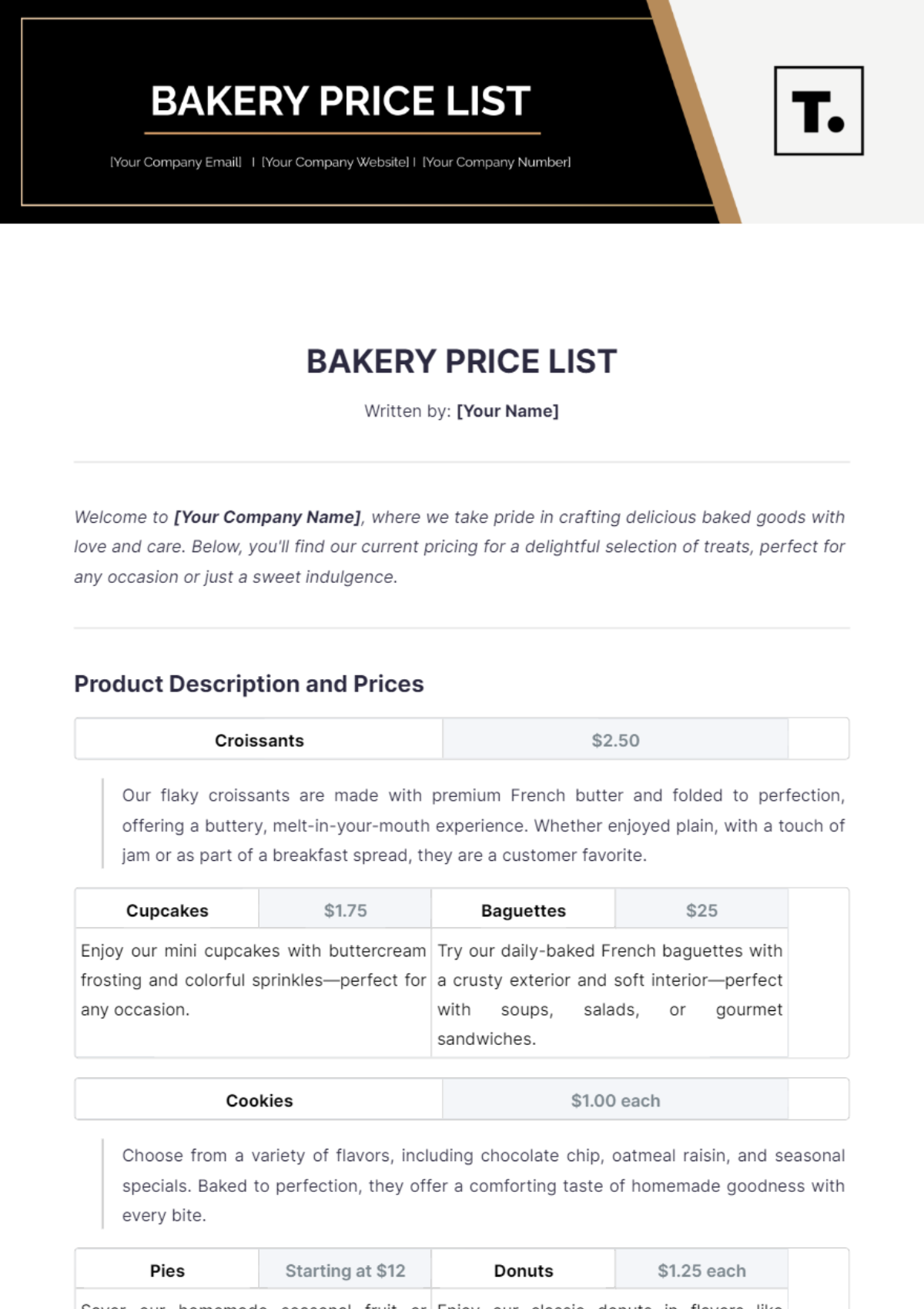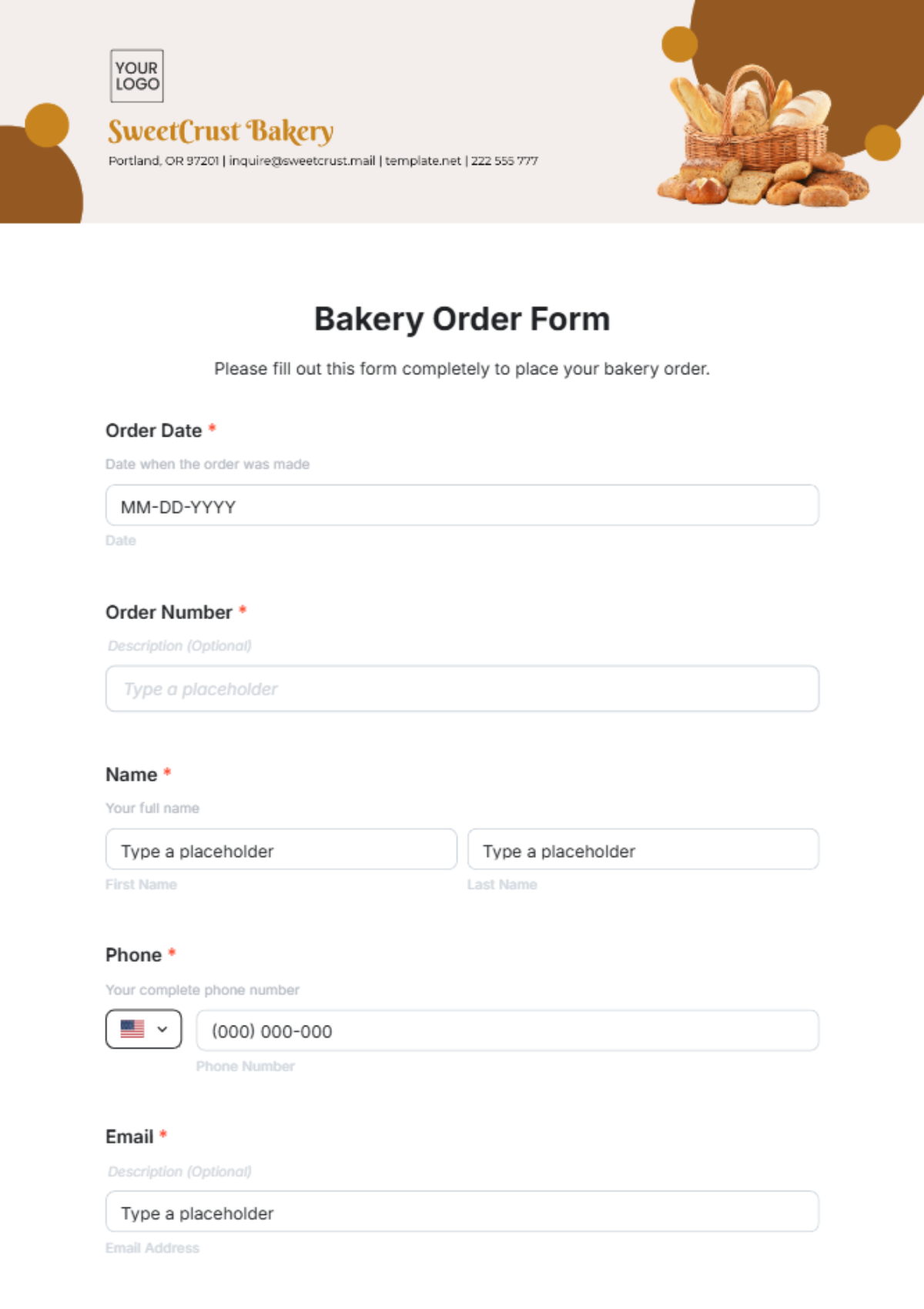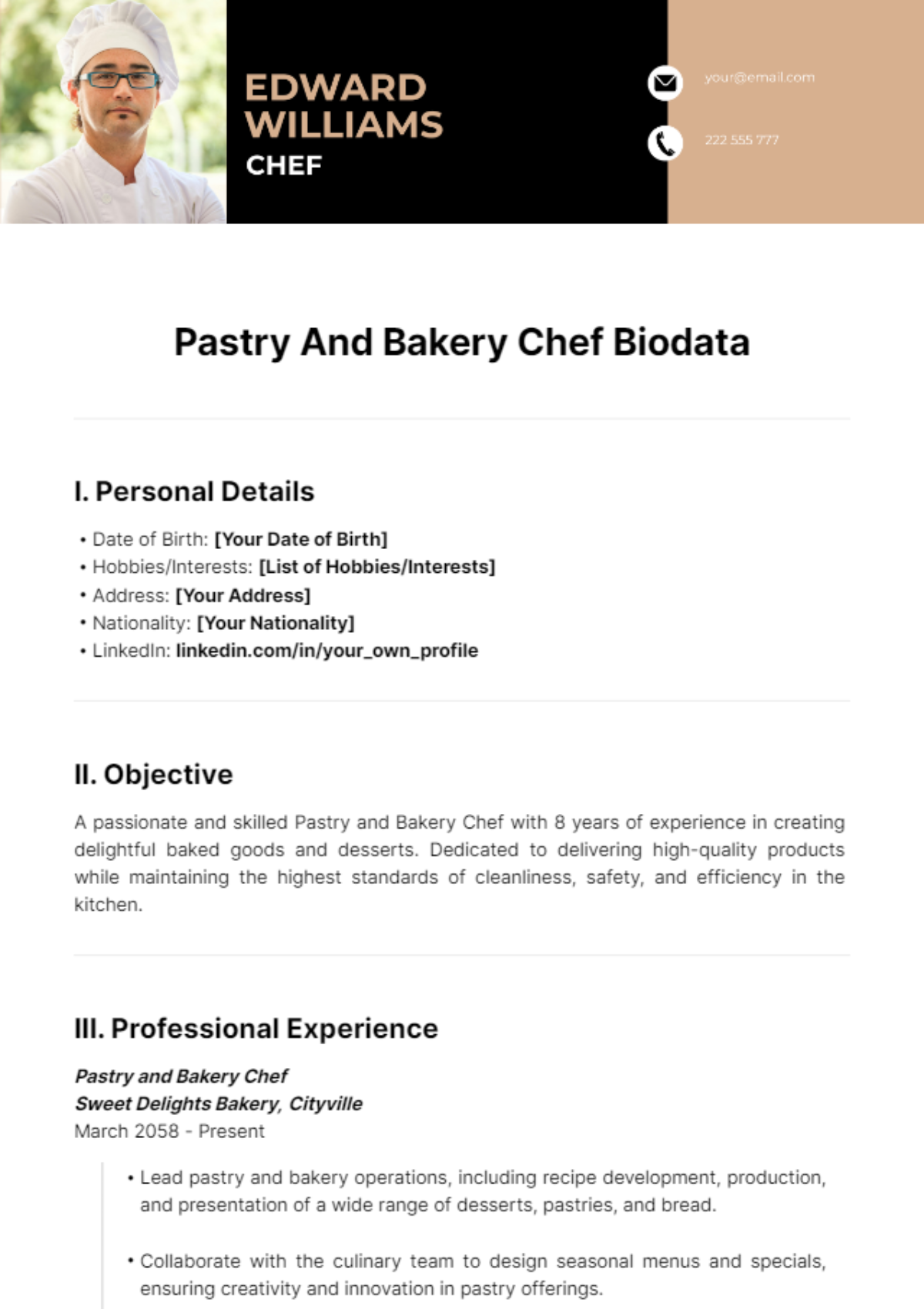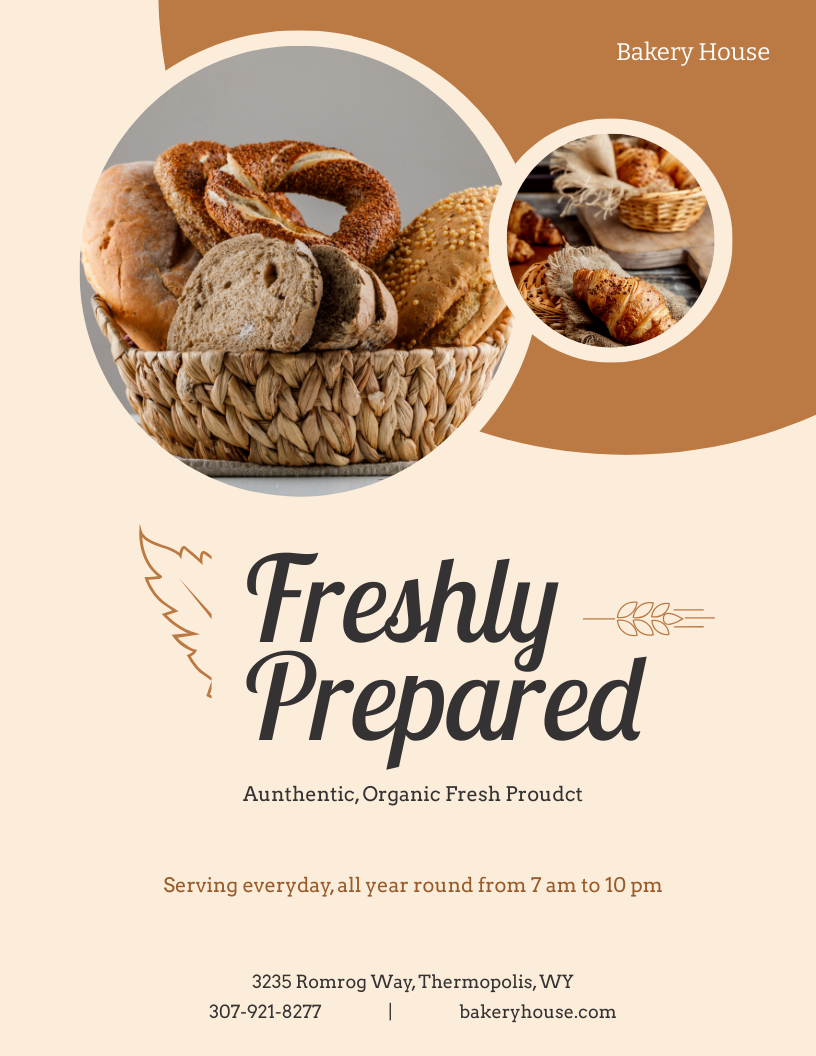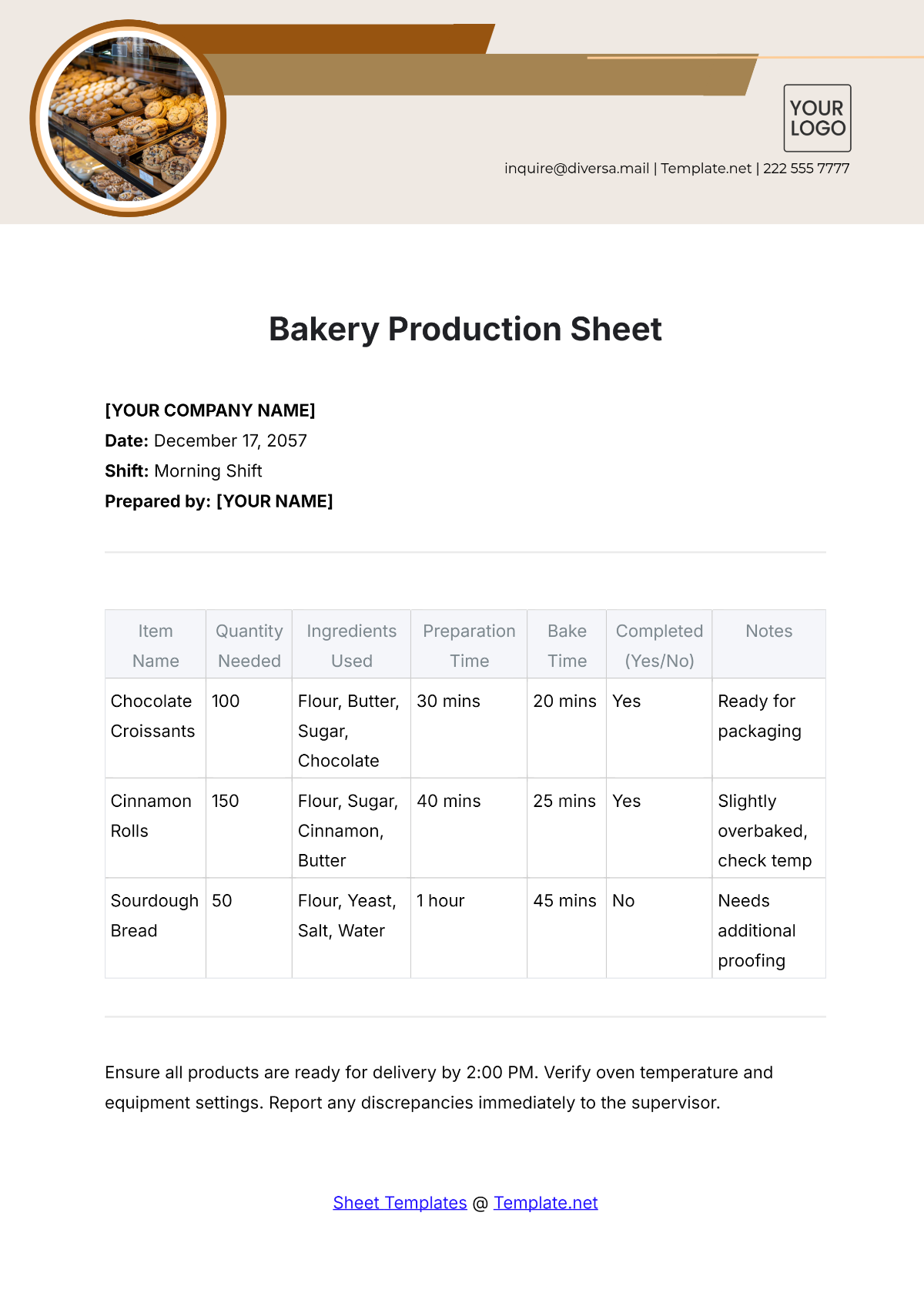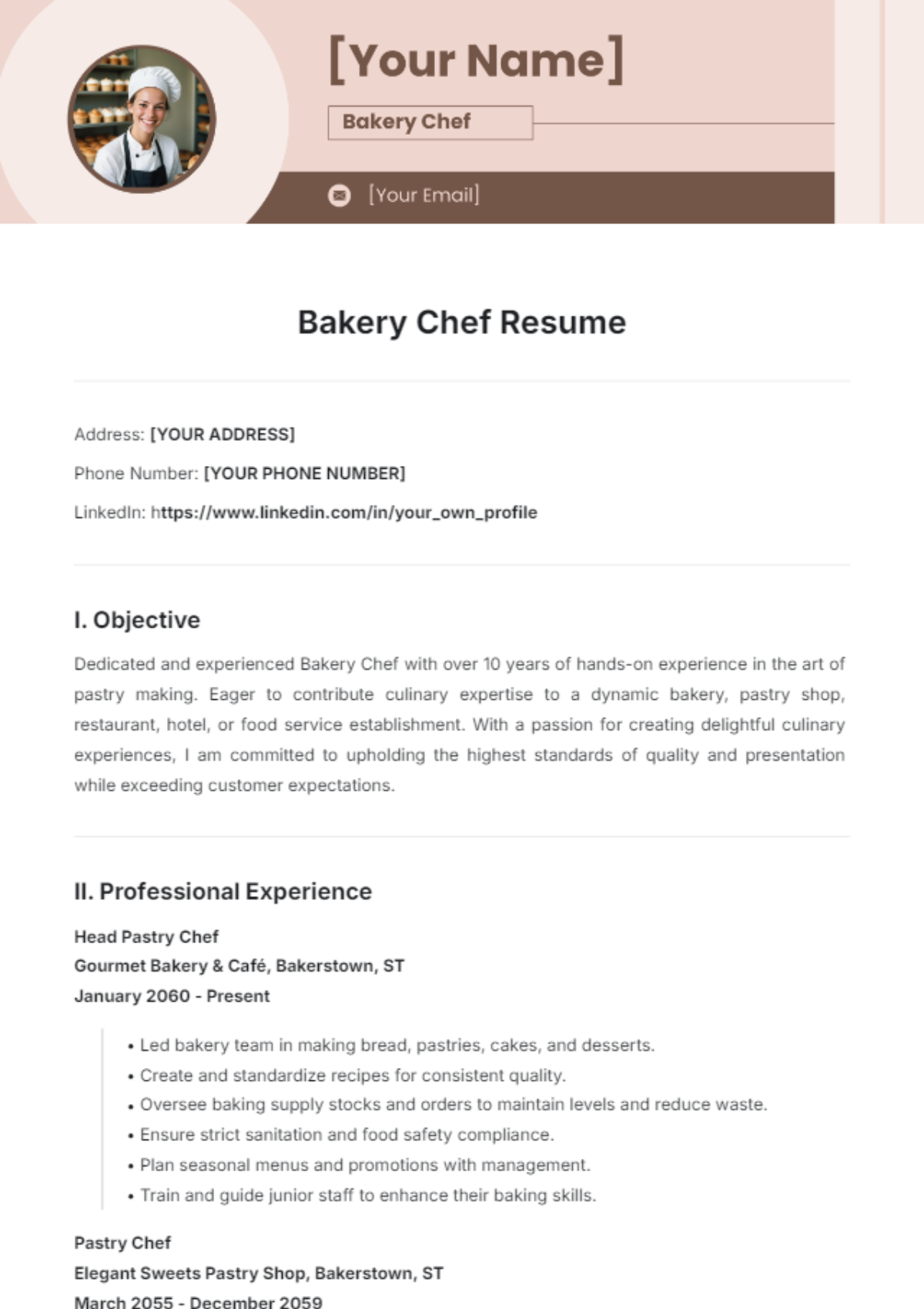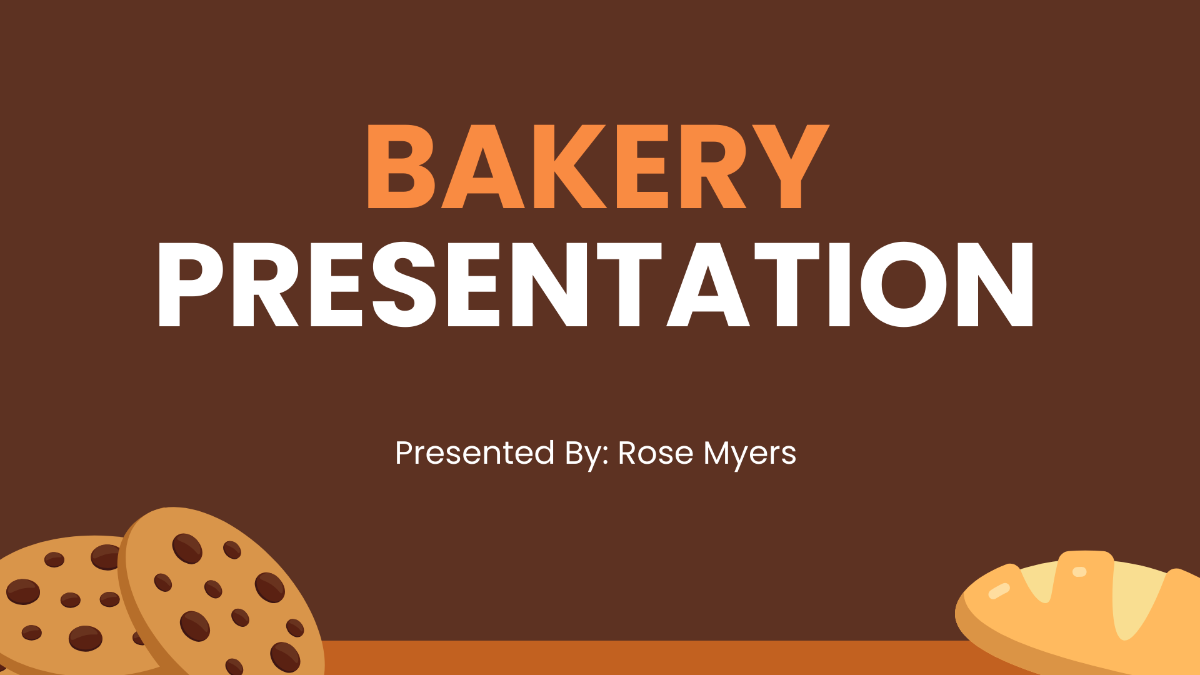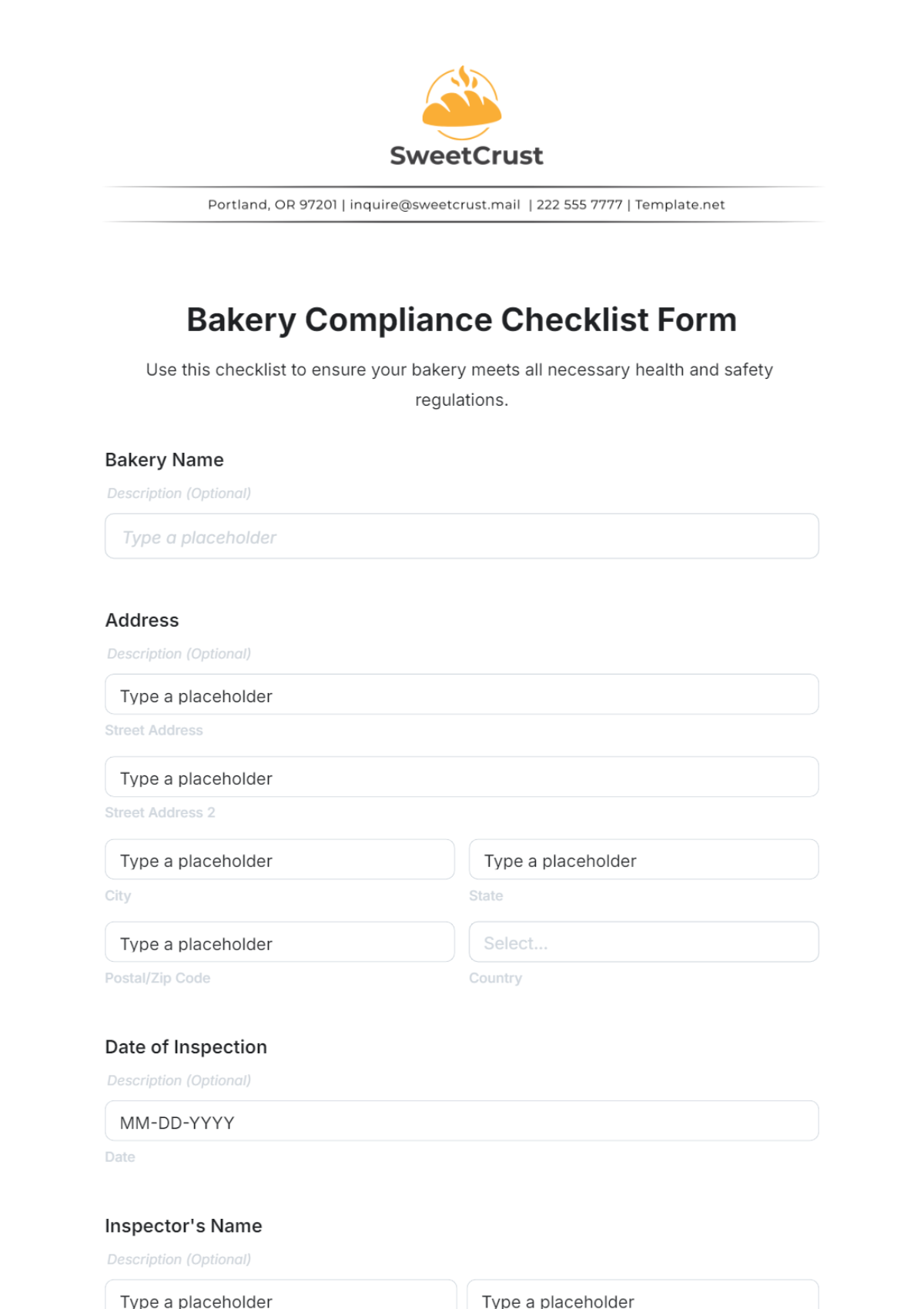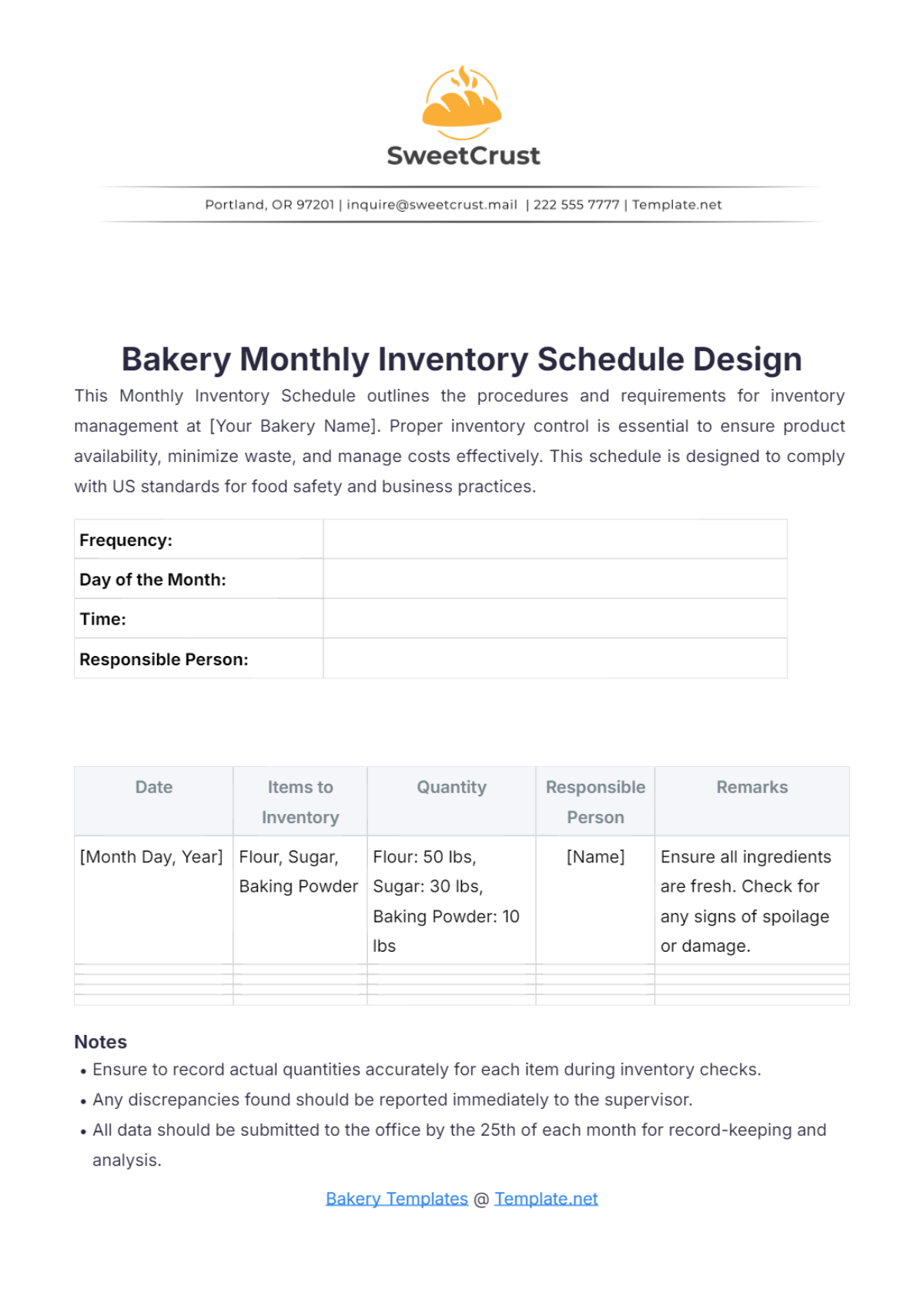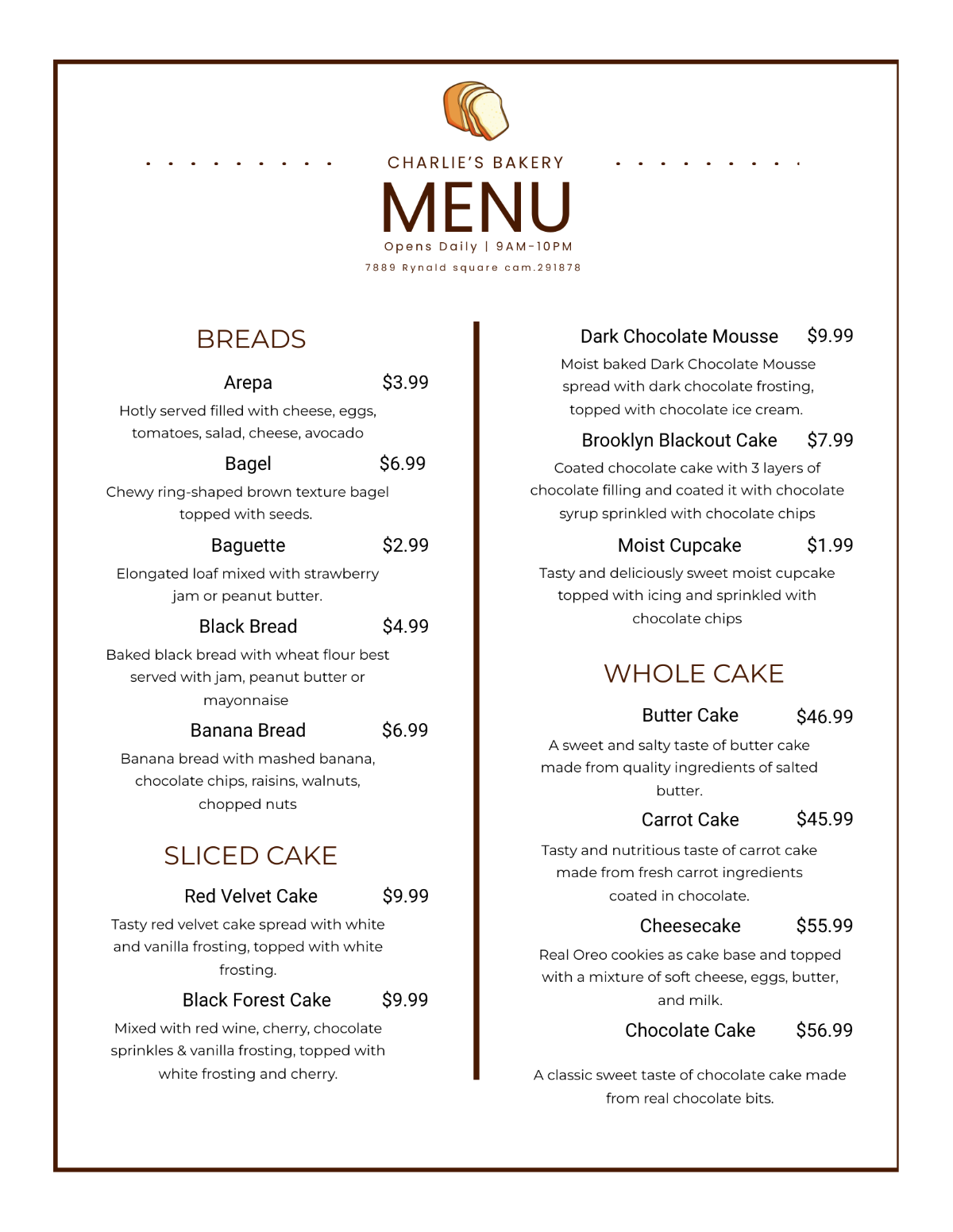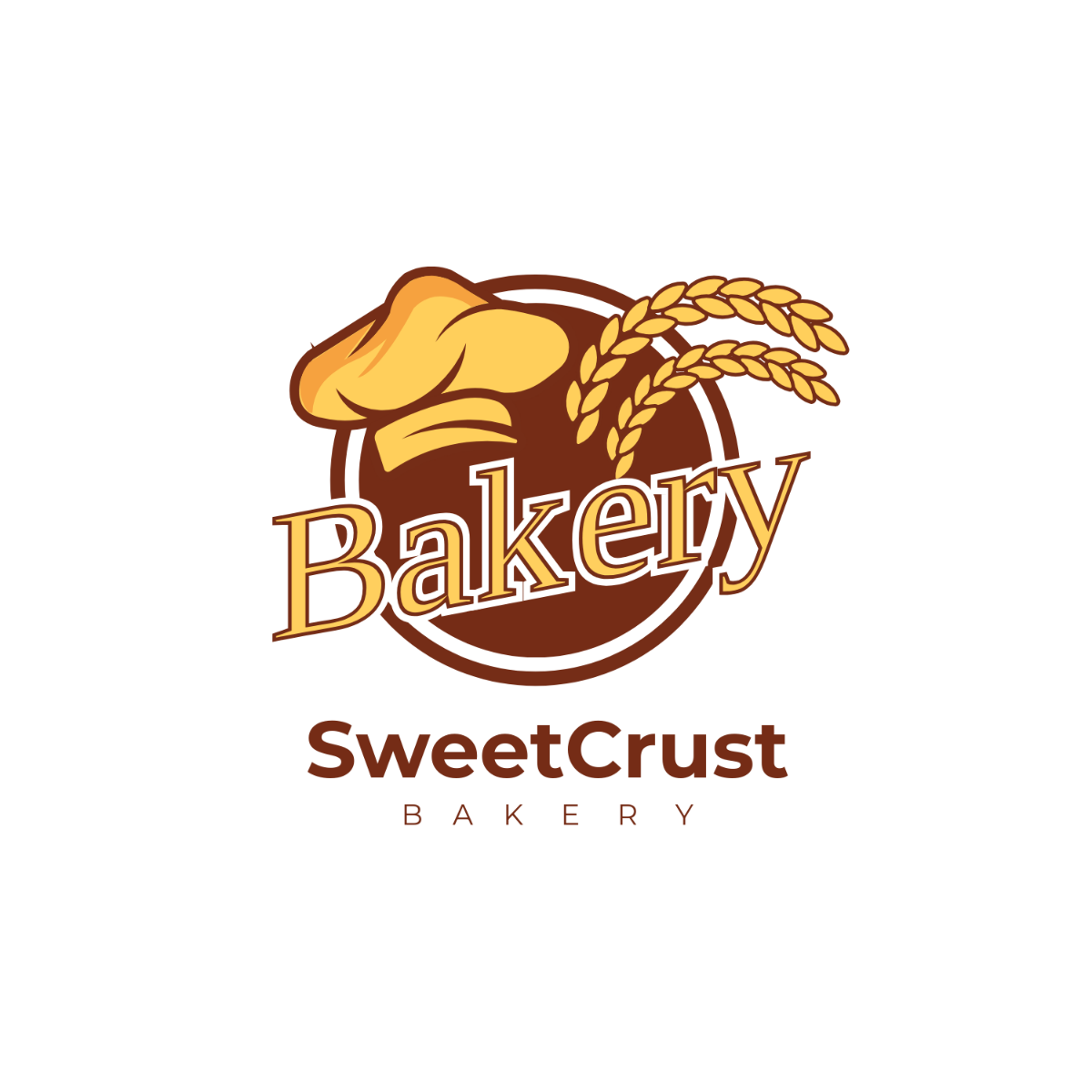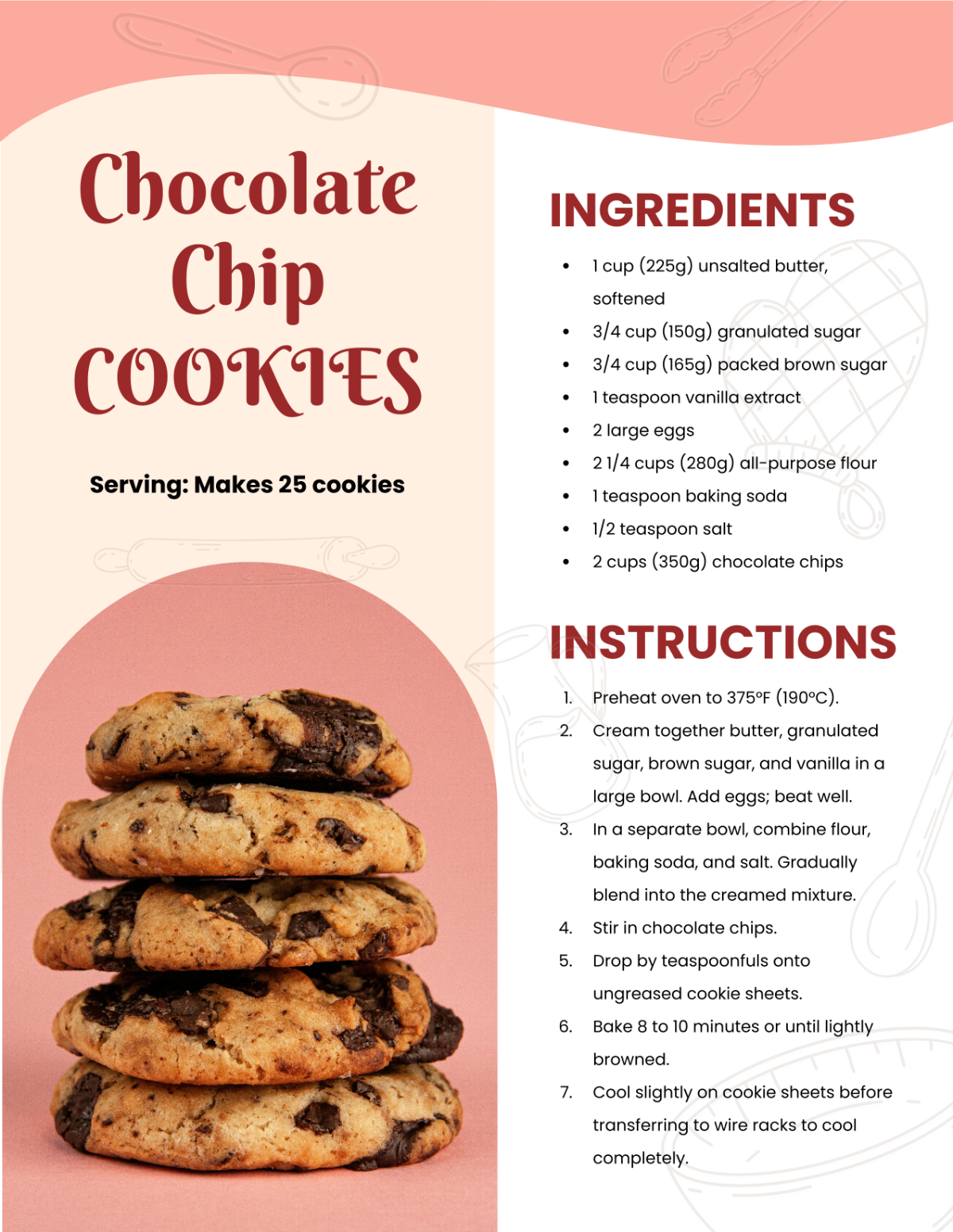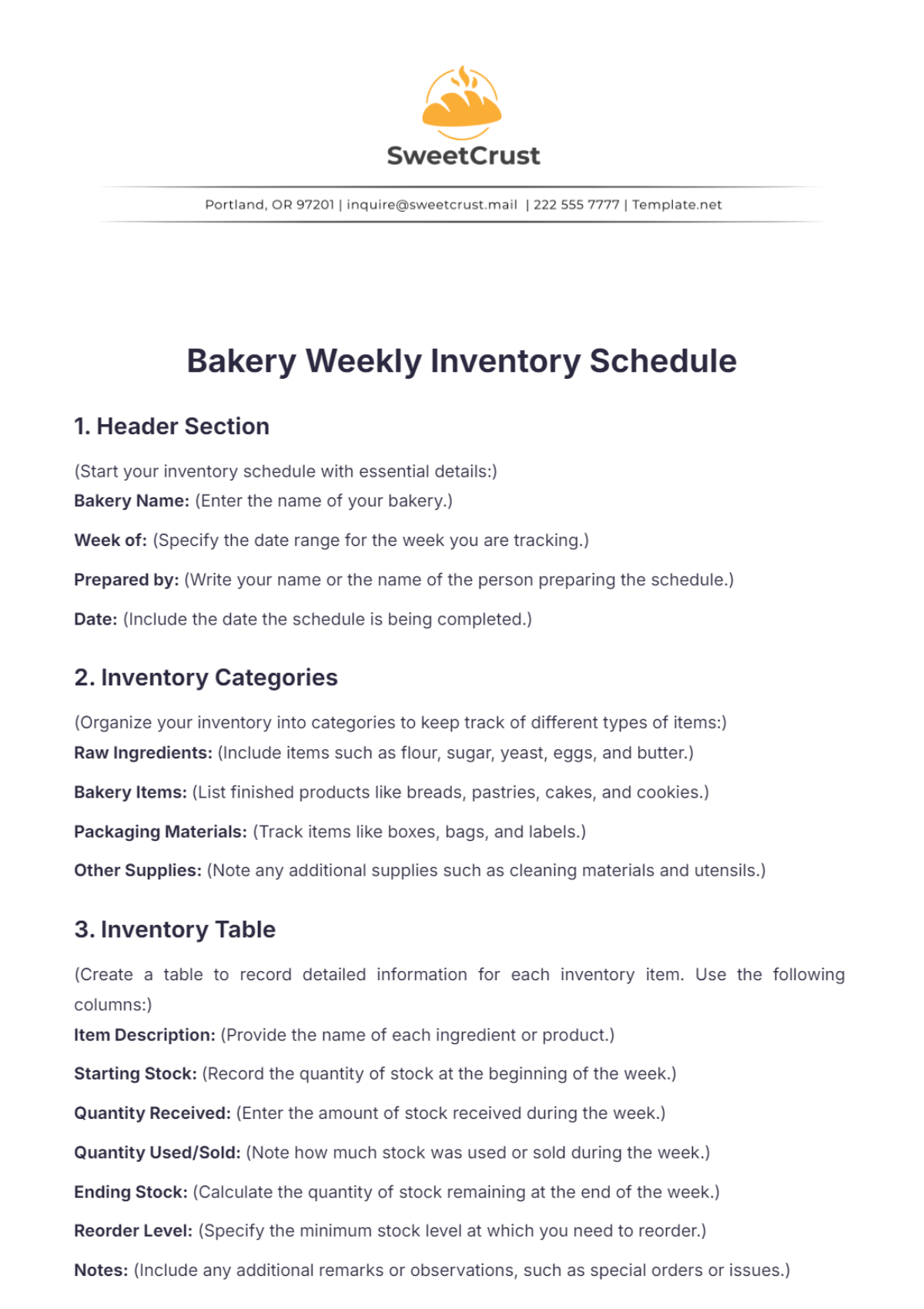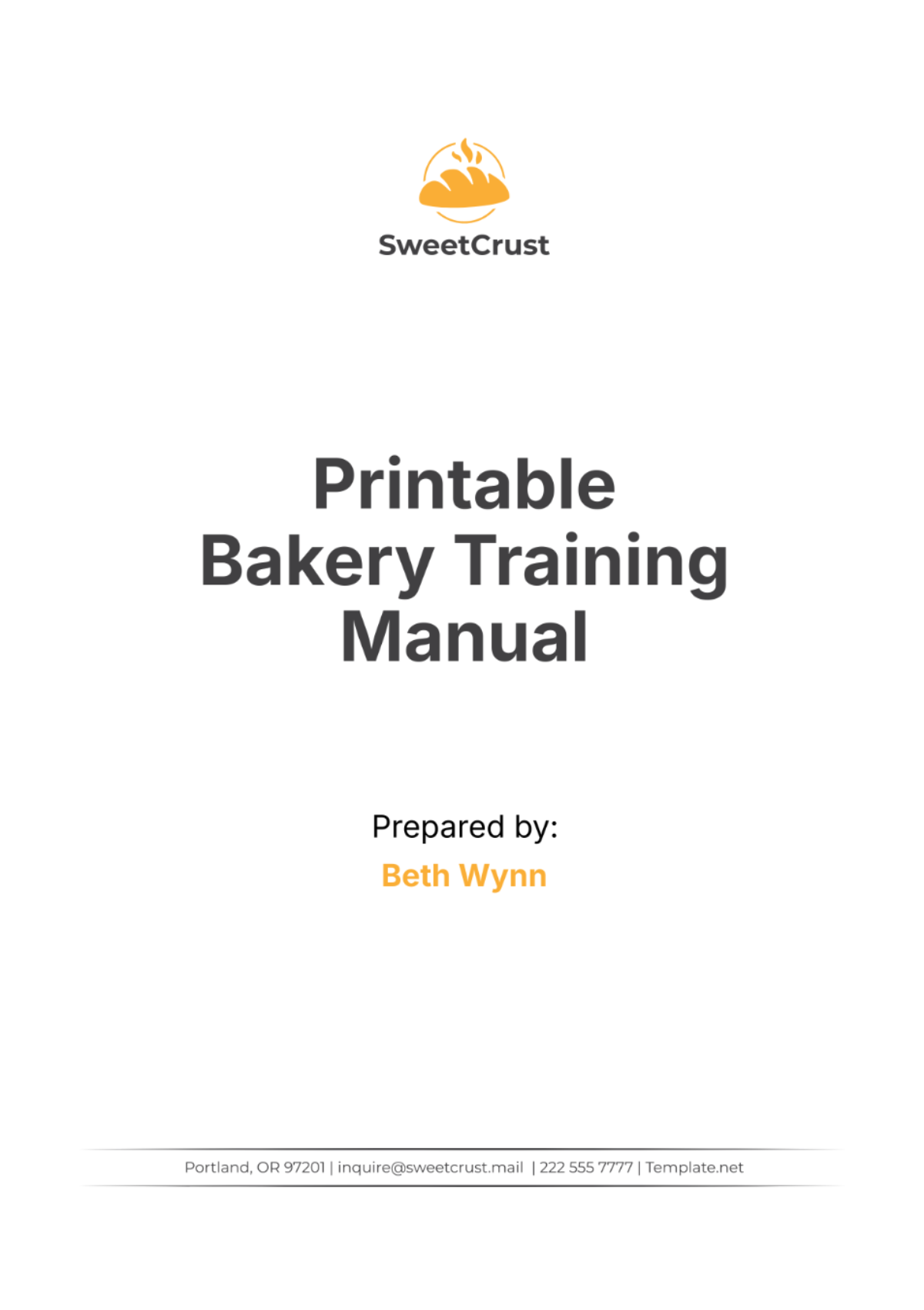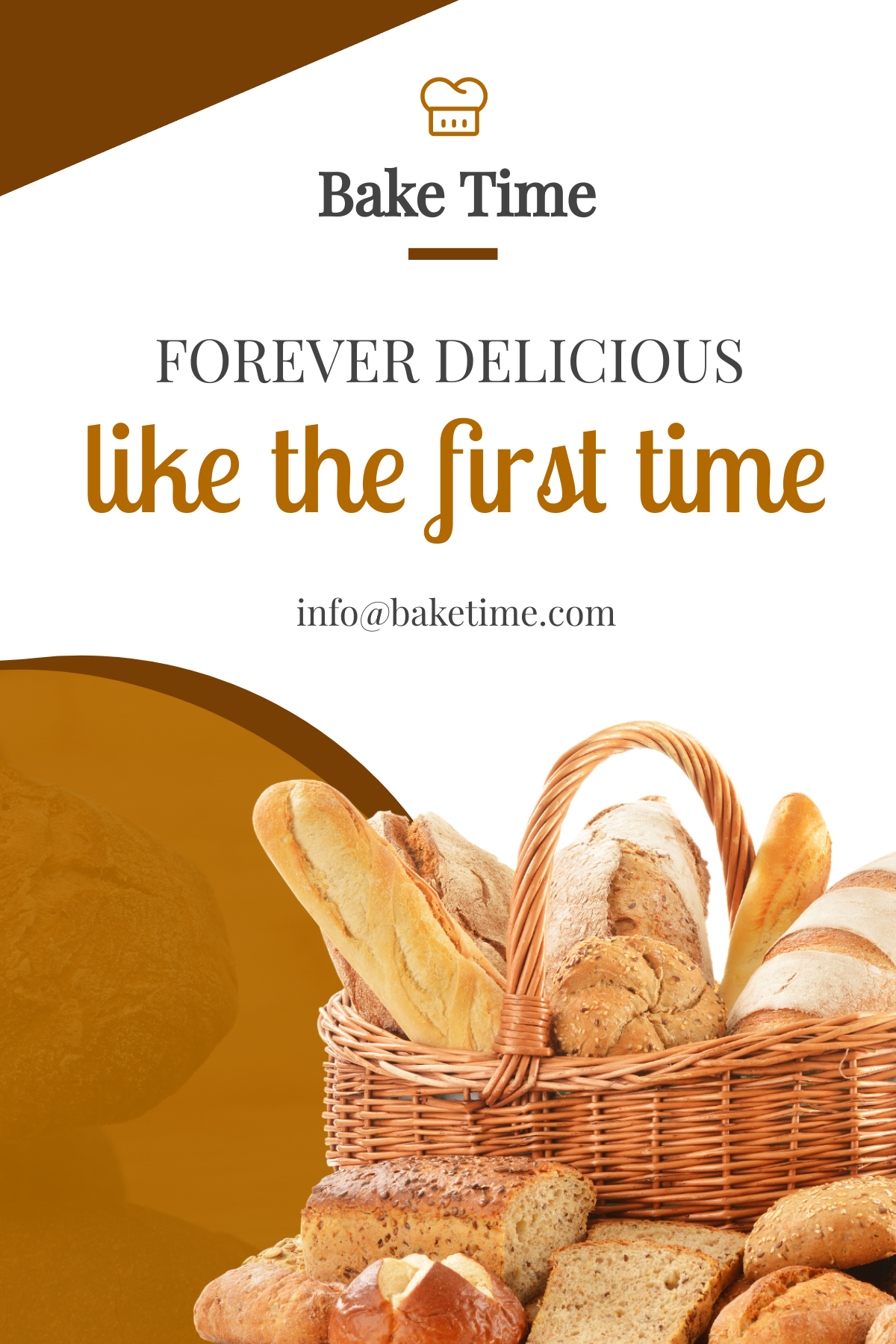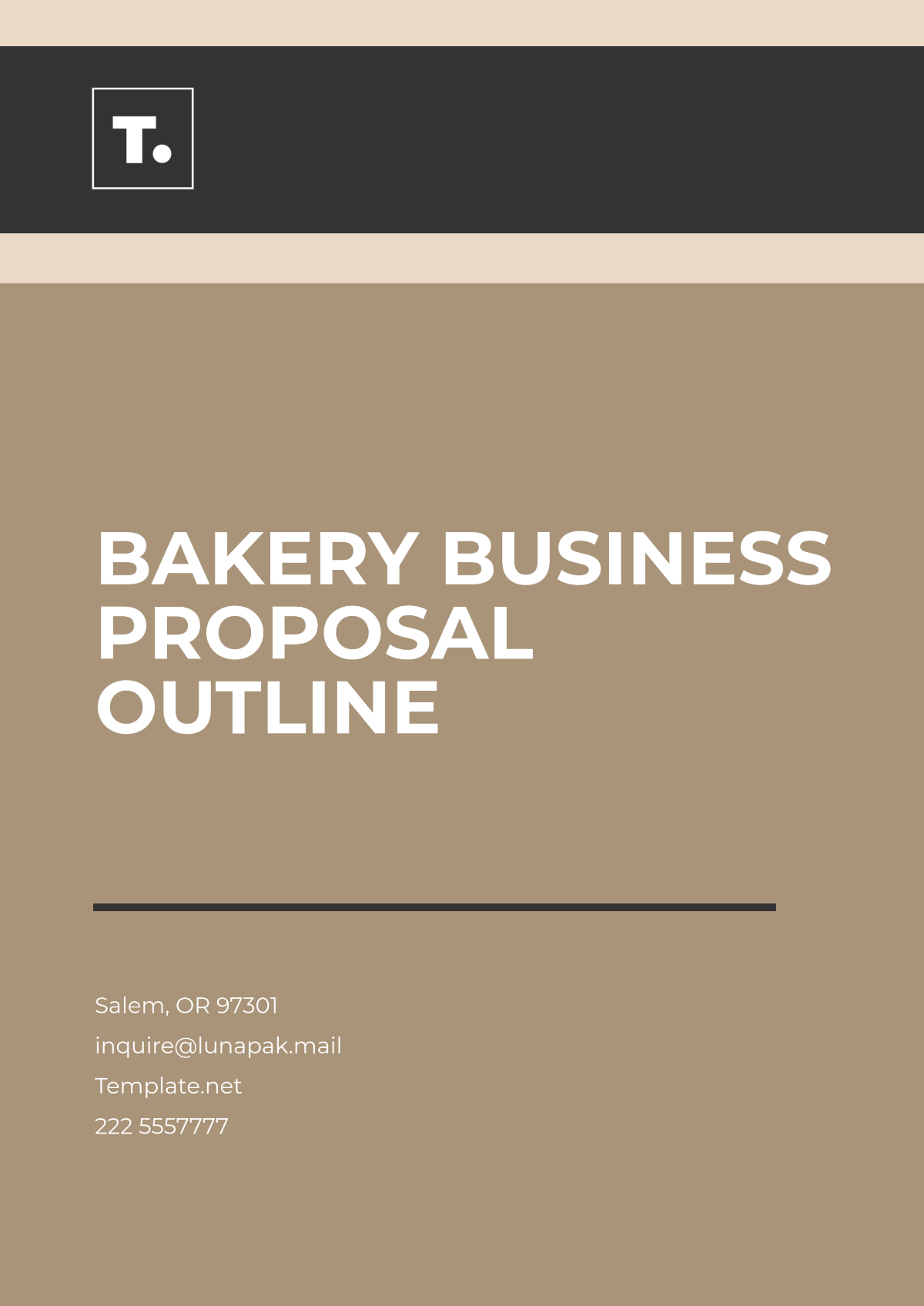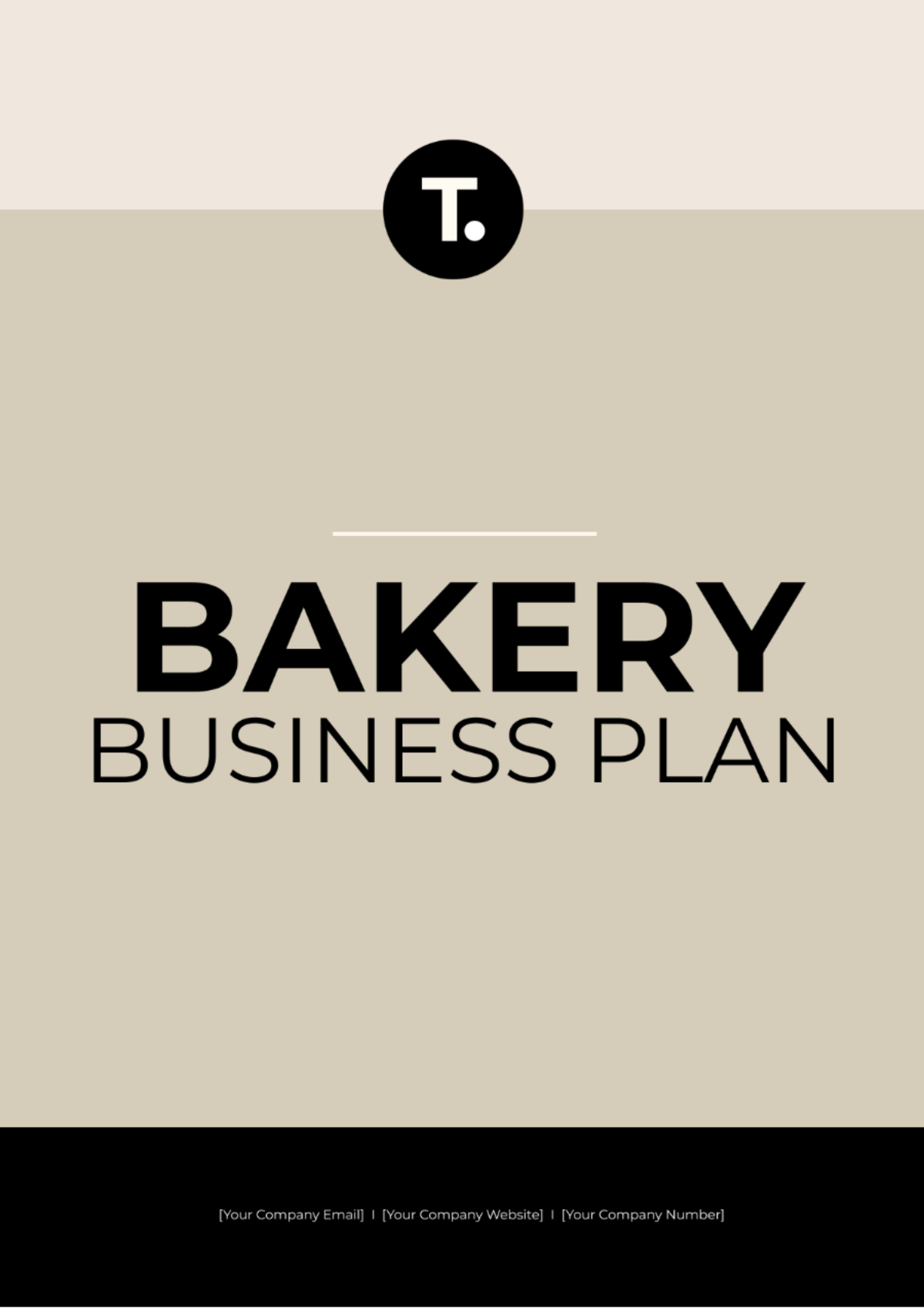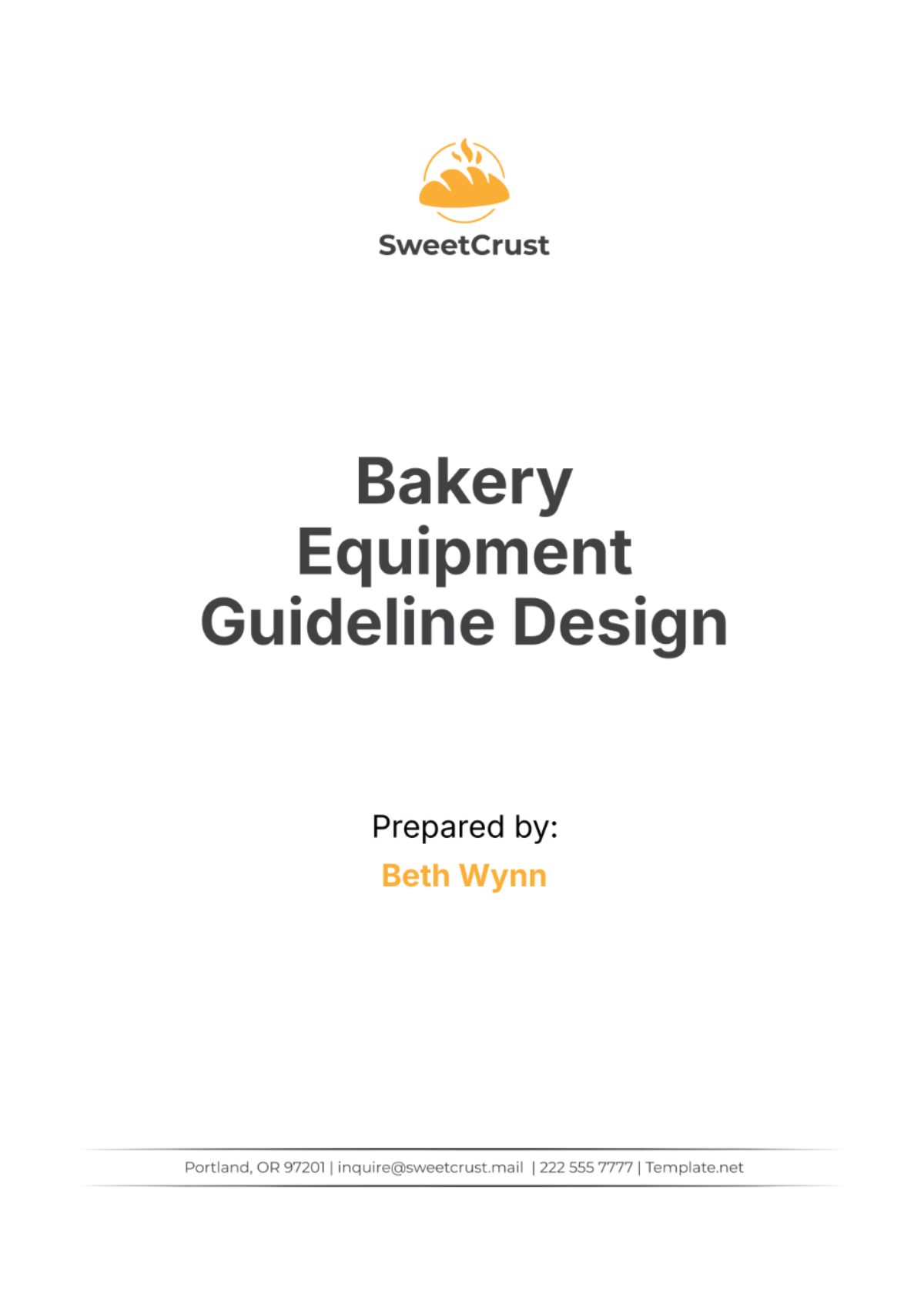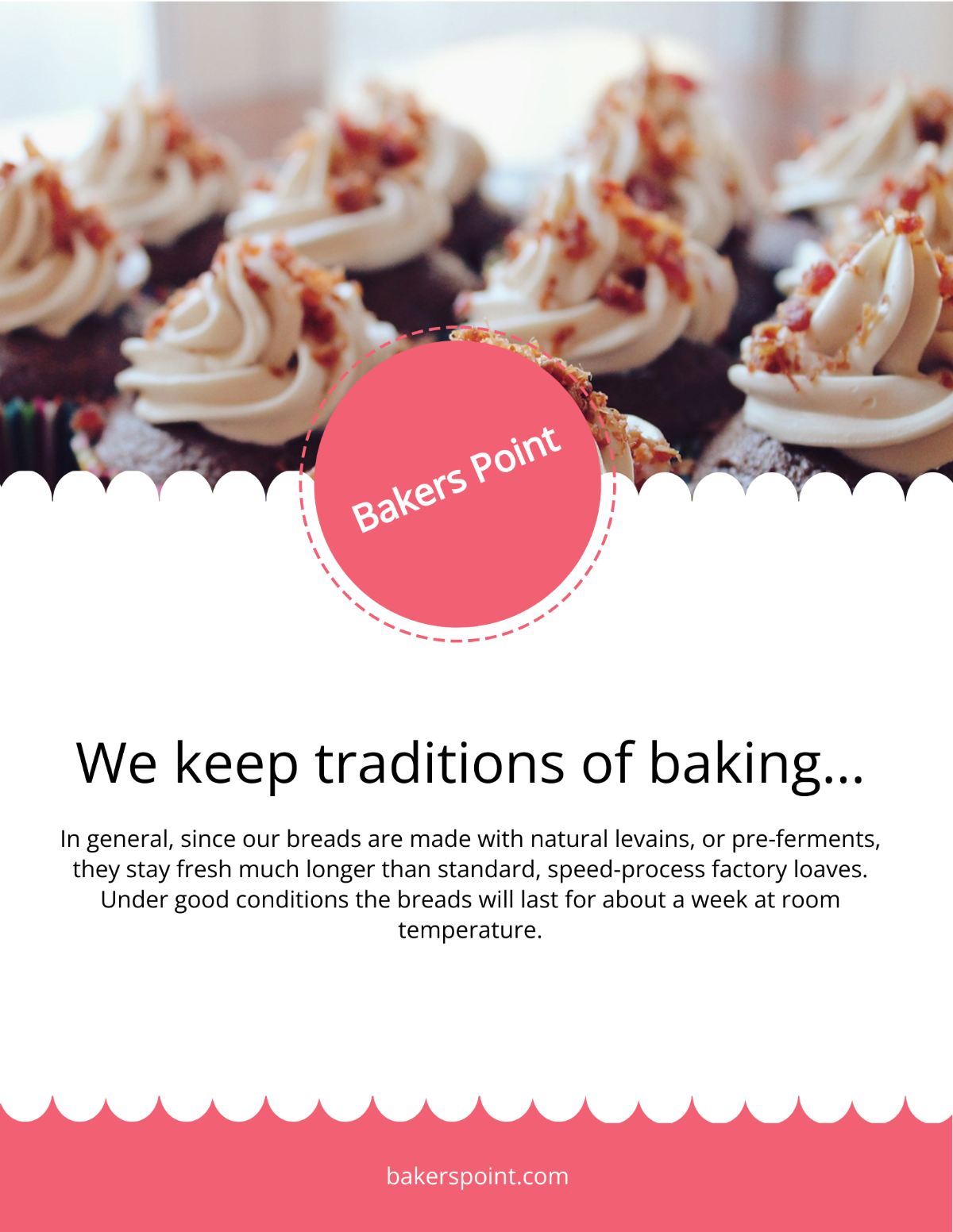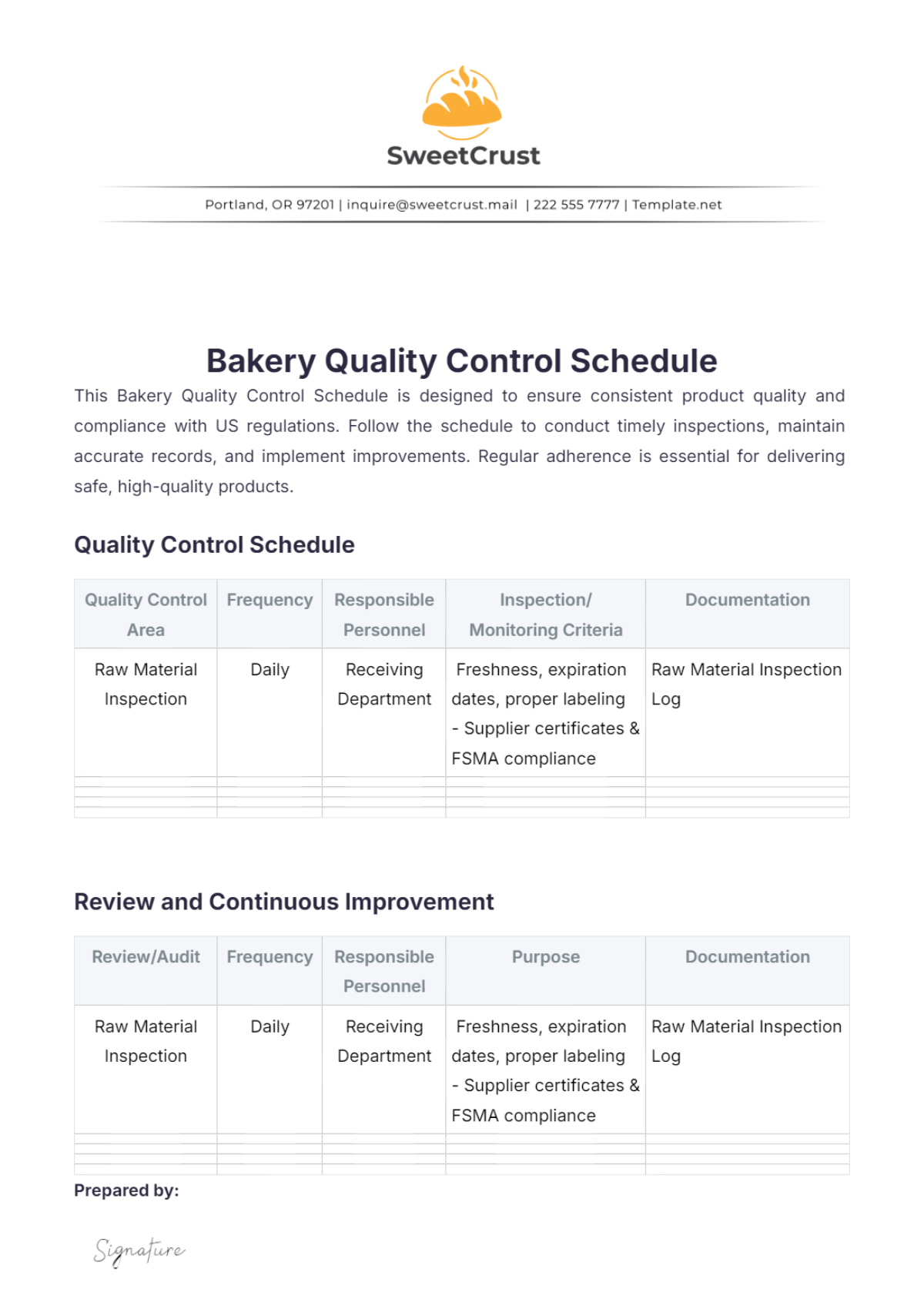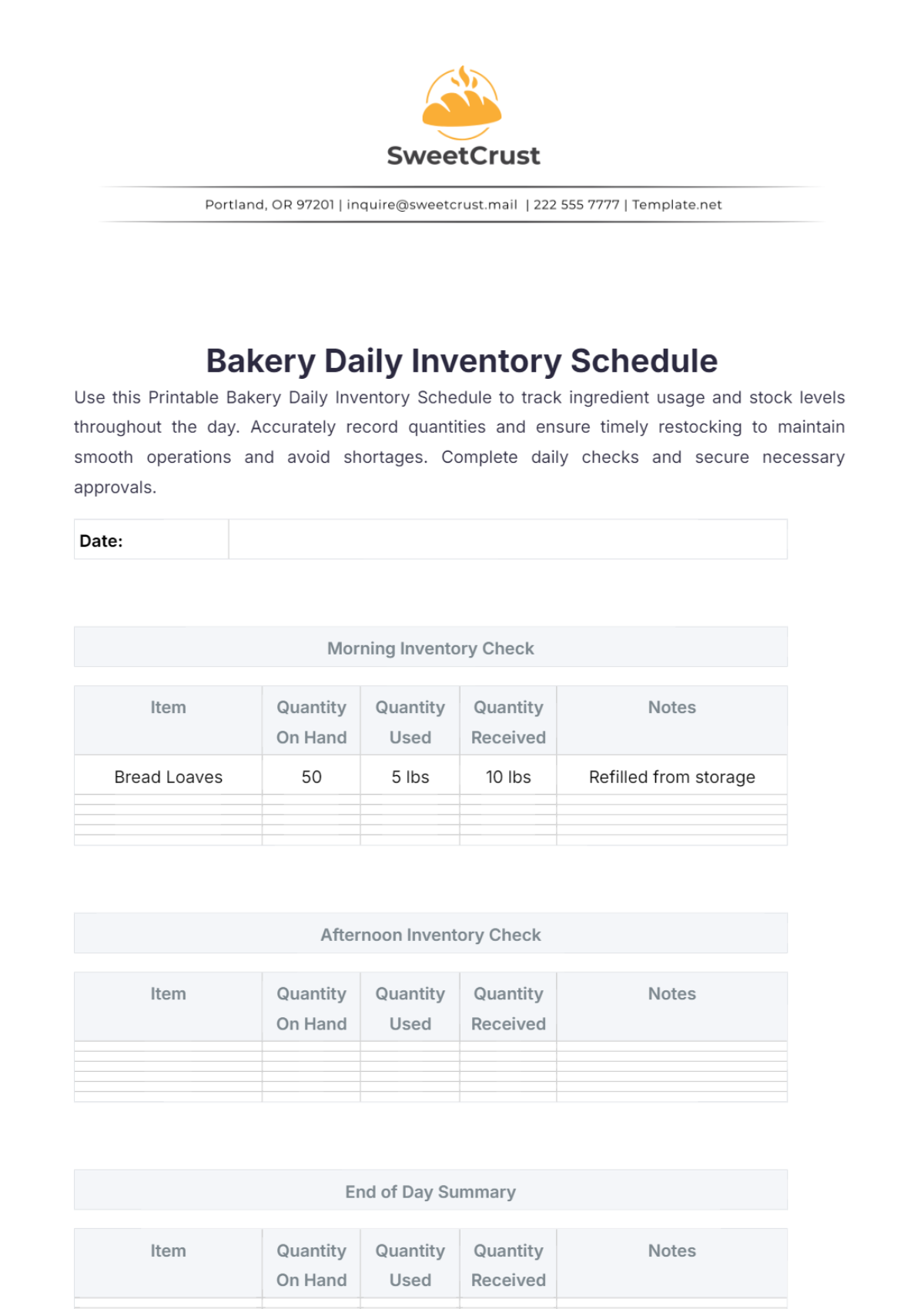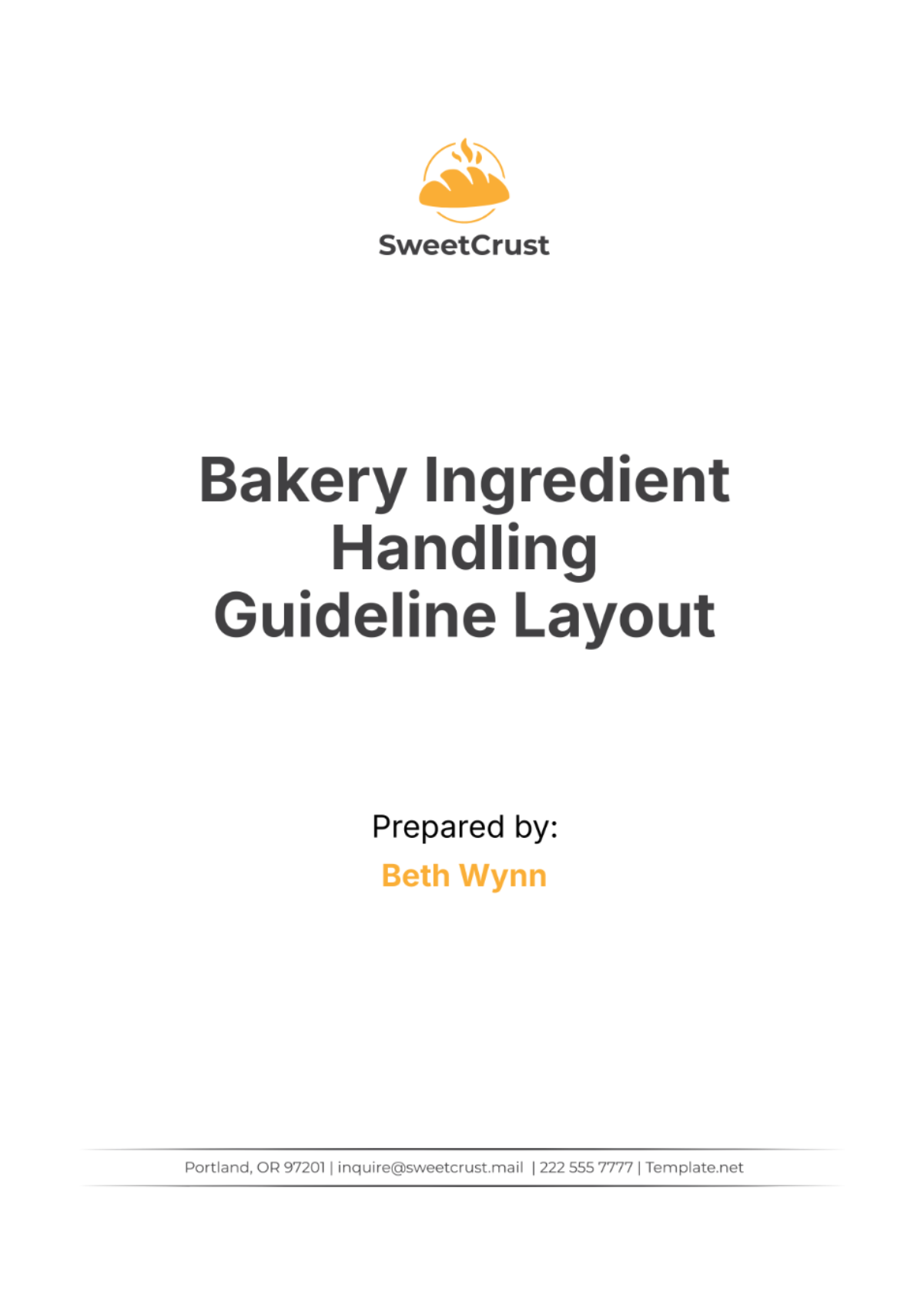Bakery Workflow Guideline Format
I. Introduction
A. Purpose of the Guideline
This Bakery Workflow Guideline serves as a comprehensive resource for managing the daily operations of [Your Company Name]'s bakery. The primary goal of this guideline is to standardize procedures across all bakery activities, ensuring a high level of efficiency and consistency. By providing clear instructions and best practices, the guideline aims to streamline operations, reduce errors, and enhance the overall quality of our baked goods. Consistent adherence to these procedures will help maintain a positive reputation for our bakery, promote customer satisfaction, and drive continued success in a competitive market.
B. Scope
The scope of this guideline encompasses every aspect of the bakery's operations, from the initial stages of ingredient procurement to the final steps of customer service. This includes detailed processes for sourcing ingredients, preparing dough and batter, baking, decorating, packaging, and interacting with customers. Additionally, it addresses crucial areas such as hygiene and safety, staff training, quality control, marketing, financial management, and sustainability practices. By covering these areas comprehensively, the guideline ensures that all employees are well-informed and equipped to perform their duties effectively, contributing to a well-organized and successful bakery operation.
C. Audience
This guideline is intended for all employees at [Your Company Name], encompassing a wide range of roles within the bakery. This includes bakers who are responsible for creating high-quality products, pastry chefs who focus on intricate designs and decorations, kitchen assistants who support daily operations, packaging staff who ensure products are properly packaged, and customer service representatives who interact directly with customers. Additionally, managers and supervisors will find this guideline valuable for overseeing operations, ensuring compliance with standards, and addressing any issues that arise. By providing a clear and comprehensive framework, this guideline helps ensure that every team member is aligned with the bakery's operational standards and goals.
II. Ingredient Procurement and Inventory Management
A. Supplier Management
Selecting Suppliers: The selection of suppliers is a critical component in maintaining the quality of our bakery products. Choose suppliers who offer high-quality ingredients and demonstrate reliability in their delivery schedules. Establishing long-term relationships with suppliers can help ensure a steady supply of necessary ingredients and potentially provide opportunities for better pricing or exclusive products. Regularly evaluate supplier performance to ensure they continue to meet our standards and consider alternatives if issues arise.
Order Placement: Orders should be placed on a regular schedule, such as weekly or bi-weekly, based on current inventory levels and anticipated demand. Accurate forecasting and planning are essential to avoid both shortages and excess inventory. Before placing an order, review current stock levels and sales forecasts to determine the required quantities. Use an inventory management system to automate this process where possible, reducing the risk of human error and ensuring timely delivery of ingredients.
Receiving Orders: Upon receiving deliveries, inspect each shipment carefully to verify that the correct items have been received in the appropriate quantities. Check for any signs of damage or spoilage, and ensure that the products meet our quality standards. Any discrepancies or issues should be documented and reported to the supplier immediately to facilitate a resolution. Proper documentation of received orders helps maintain accurate inventory records and ensures that any issues are addressed promptly.
B. Inventory Control
Stock Monitoring: Effective inventory management involves continuous monitoring of ingredient levels to ensure that the bakery operates smoothly. Use an inventory management system to track stock levels in real-time and generate reports on usage patterns. Regularly review inventory data to identify trends and adjust ordering practices accordingly. By maintaining an accurate picture of stock levels, you can prevent overstocking and understocking, which can impact production and profitability.
Storage Guidelines: Proper storage of ingredients is crucial for maintaining their quality and extending their shelf life. Store dry ingredients in a cool, dry place, and keep perishable items in refrigeration or freezing as appropriate. Clearly label all items with the date of receipt and use a FIFO (First In, First Out) system to ensure that older stock is used before newer stock. Regularly inspect storage areas for signs of contamination or spoilage and address any issues immediately to prevent food safety problems.
Waste Reduction: Implement strategies to minimize waste and maximize the use of available ingredients. Monitor ingredient usage and analyze any discrepancies to identify potential sources of waste. Consider repurposing surplus ingredients into new products or offering discounts on items nearing their expiration date to reduce waste. Educate staff on the importance of waste reduction and involve them in identifying and implementing waste-saving measures.
III. Preparation and Baking
A. Recipe Standardization
Recipe Documentation: Maintain a detailed recipe book that includes precise measurements, instructions, and cooking times for all bakery products. Each recipe should be documented clearly to ensure consistency and quality across different batches. Regularly review and update recipes based on feedback and performance to keep them relevant and effective. Make sure that all staff members have access to the recipe book and are trained on its use to ensure uniformity in product preparation.
Scaling Ingredients: Accurate measurement of ingredients is essential for achieving the desired texture and flavor in baked goods. Use digital scales and measuring tools to ensure precise quantities for each recipe. When scaling recipes for larger batches, use conversion formulas to adjust ingredient amounts while maintaining the correct proportions. Consistency in ingredient scaling helps ensure that each batch of products meets the same high standards of quality.
B. Dough and Batter Preparation
Mixing Techniques: Follow established mixing procedures for different types of dough and batter to achieve the desired consistency and texture. This includes specific mixing times, speeds, and techniques for each recipe. Over-mixing or under-mixing can affect the final product's quality, so it is important to adhere to the recommended procedures. Regularly train staff on proper mixing techniques and provide guidance to ensure that they understand the impact of these techniques on product outcomes.
Proofing and Resting: Proper proofing and resting of dough are essential for achieving the right rise and texture in baked goods. Follow the recommended proofing times and temperatures for each type of dough, and monitor the process closely to ensure optimal results. Inadequate proofing can result in dense or uneven products, so it is important to adhere to the specified conditions. Consider using proofing cabinets or other specialized equipment to control temperature and humidity during the proofing process.
Portioning and Shaping: Consistent portioning and shaping of dough are important for ensuring uniformity in the final products. Use standardized tools and techniques to measure and shape dough to the required specifications. Proper portioning helps maintain consistency in product size and appearance, while accurate shaping contributes to the overall quality and presentation of the baked goods. Train staff on the importance of consistency in portioning and shaping to ensure that all products meet the same high standards.
C. Baking Process
Oven Management: Effective oven management is critical for achieving consistent baking results. Preheat ovens to the required temperatures before placing products inside to ensure even cooking. Regularly calibrate ovens to maintain accurate temperature settings and address any issues promptly. Consider using temperature probes and other monitoring tools to track oven performance and ensure that baking conditions are optimal for each batch.
Baking Times and Temperatures: Adhere to specified baking times and temperatures for each product to achieve the desired texture, color, and flavor. Monitor products closely during baking to prevent overcooking or undercooking. Use timers and temperature gauges to ensure precise control over the baking process. Regularly review and adjust baking times and temperatures based on performance data and feedback to optimize results.
Cooling and Storage: Proper cooling and storage of baked goods are essential for maintaining freshness and quality. Allow products to cool completely on racks before packaging to prevent condensation and maintain texture. Store finished products in a controlled environment to extend shelf life and preserve flavor. Regularly inspect storage areas for signs of contamination or spoilage and address any issues promptly to ensure product safety.
IV. Decorating and Packaging
A. Decorating Techniques
Frosting and Glazing: Apply consistent techniques for frosting and glazing to ensure uniformity in product appearance. Use high-quality ingredients and follow established methods to achieve the desired look and flavor. Properly prepare and handle frosting and glazing mixtures to ensure smooth application and avoid imperfections. Train staff on decorating techniques and provide ongoing guidance to maintain consistency and quality in finished products.
Piping and Garnishing: Utilize standard piping and garnishing methods for decorating cakes, pastries, and other baked goods. Use appropriate tools and techniques to achieve professional results and enhance product presentation. Regularly practice and refine piping skills to ensure precision and consistency. Provide training and resources for staff to develop their decorating skills and stay updated on new trends and techniques.
B. Packaging Standards
Packaging Materials: Choose packaging materials that protect products during transportation and storage while preserving their freshness. Select materials that are both functional and aesthetically pleasing, and consider eco-friendly options to reduce environmental impact. Ensure that packaging is durable and suitable for the type of product being packaged. Regularly review packaging options and make improvements as needed to enhance product presentation and sustainability.
Labeling and Branding: Accurately label all products with essential information, including ingredients, expiration dates, and branding details. Consistent labeling helps maintain transparency and provides customers with important product information. Ensure that branding elements, such as logos and colors, are applied uniformly to reinforce the bakery's identity. Regularly review and update labels to comply with regulatory requirements and reflect any changes in product information.
Customer Presentation: Package products attractively to enhance customer appeal and satisfaction. Pay attention to details such as neatness, uniformity, and presentation to create a positive impression. Consider incorporating elements such as custom packaging or branded stickers to add a personal touch. Regularly assess customer feedback on packaging and presentation to identify areas for improvement and make adjustments as needed.
V. Customer Service
A. Point of Sale (POS) Operations
Cash Handling: Train staff on proper cash handling procedures to ensure accurate and secure transactions. This includes operating the POS system, processing payments, and providing correct change. Implement procedures for handling cash discrepancies and ensure that all transactions are recorded accurately. Regularly review cash handling practices to identify potential areas for improvement and ensure compliance with best practices.
Order Accuracy: Verify customer orders before processing to ensure accuracy and prevent errors. Double-check orders for special requests, modifications, or dietary restrictions to ensure that they are fulfilled correctly. Implement a system for order verification and review to minimize mistakes and enhance customer satisfaction. Provide staff with tools and resources to help them manage complex orders effectively.
Customer Interaction: Foster positive customer interactions by training staff in effective communication and customer service skills. Encourage staff to be polite, attentive, and responsive to customer needs. Provide staff with guidelines for handling various customer scenarios, such as complaints or special requests, to ensure consistent and professional service. Regularly review customer service performance and provide feedback and support to enhance staff skills.
B. Handling Customer Complaints
Listening to Customers: Encourage staff to listen actively to customer complaints and concerns with empathy and understanding. Acknowledge the issue and validate the customer's feelings to demonstrate that their concerns are taken seriously. Provide staff with training on active listening techniques and customer empathy to improve their ability to handle complaints effectively.
Resolving Issues: Empower staff to resolve minor issues independently and escalate more complex problems to supervisors or managers as needed. Aim to address complaints promptly and find satisfactory solutions to maintain customer satisfaction. Implement a system for tracking and documenting complaints to identify patterns and address recurring issues. Regularly review complaint resolution practices to ensure that they are effective and aligned with customer expectations.
Feedback Mechanism: Implement a system for collecting and analyzing customer feedback, such as surveys, comment cards, or online reviews. Use feedback to identify areas for improvement and make necessary adjustments to operations. Encourage customers to provide feedback and express their opinions on various aspects of the bakery experience. Regularly review feedback data and take actionable steps to enhance the overall customer experience.
VI. Hygiene and Safety
A. Personal Hygiene
Handwashing: Enforce strict handwashing protocols to ensure that all staff maintain high levels of personal hygiene. Hands should be washed thoroughly before handling food, after using the restroom, and after any activity that could contaminate hands. Provide handwashing stations with soap, water, and hand sanitizers to facilitate regular handwashing. Conduct regular training and reminders on proper handwashing techniques to prevent contamination.
Uniforms and Protective Gear: Require staff to wear clean uniforms and appropriate protective gear, such as hairnets, gloves, and aprons, to maintain hygiene standards and prevent contamination. Implement policies for uniform cleanliness and replacement to ensure that staff always adhere to hygiene requirements. Provide training on the proper use and care of protective gear to ensure that it is effective in maintaining food safety.
Health Monitoring: Monitor staff health and ensure that anyone exhibiting symptoms of illness, such as coughing, sneezing, or gastrointestinal issues, is not handling food. Implement policies for reporting and managing health issues to prevent the spread of illness. Encourage staff to seek medical attention if needed and provide support for their recovery. Regularly review health and hygiene policies to ensure they are effective and up-to-date.
B. Kitchen Sanitation
Cleaning Schedules: Develop and adhere to a comprehensive cleaning schedule for the kitchen and bakery areas. This includes daily, weekly, and monthly cleaning tasks to maintain a high standard of sanitation. Assign specific cleaning responsibilities to staff members and ensure that tasks are completed as scheduled. Regularly review and update cleaning procedures to address any changes in kitchen operations or equipment.
Waste Management: Implement effective waste management practices to prevent contamination and manage waste efficiently. This includes regular emptying and cleaning of waste bins, segregation of recyclable and non-recyclable materials, and proper disposal of food waste. Educate staff on waste management procedures and the importance of maintaining a clean and organized workspace. Monitor waste levels and implement strategies to reduce waste and improve sustainability.
Pest Control: Maintain a proactive pest control program to prevent infestations and protect the bakery environment. Regularly inspect the premises for signs of pests and address any issues promptly. Work with professional pest control services to implement preventative measures and manage any infestations effectively. Educate staff on pest prevention techniques and ensure that they follow proper procedures to minimize the risk of pests.
C. Safety Protocols
Equipment Safety: Train staff on the proper use and maintenance of kitchen equipment to ensure safety and efficiency. This includes understanding operating procedures, safety features, and routine maintenance requirements. Regularly inspect equipment for signs of wear or malfunction and address any issues immediately. Provide staff with safety guidelines and protocols to prevent accidents and ensure a safe working environment.
Emergency Procedures: Establish and communicate emergency procedures, such as fire drills, first aid protocols, and evacuation plans. Ensure that all staff are familiar with these procedures and know their roles in an emergency situation. Conduct regular drills and training sessions to keep staff prepared and informed. Review and update emergency procedures regularly to ensure they remain effective and relevant.
Accident Reporting: Implement a system for reporting and documenting accidents and near-misses to identify potential hazards and improve safety practices. Encourage staff to report incidents promptly and provide support for injury management and recovery. Analyze accident reports to identify trends and implement corrective actions to prevent future incidents. Regularly review and update safety practices based on accident data and feedback.
VII. Staff Training and Development
A. Onboarding New Employees
Orientation Program: Develop a comprehensive orientation program for new hires that provides an overview of the bakery’s operations, policies, and expectations. Include information on the bakery’s history, mission, and values to help new employees understand the company culture. Provide an introduction to key staff members and their roles to facilitate smooth integration into the team. Ensure that new hires receive all necessary resources and training materials during their orientation.
Hands-on Training: Provide hands-on training for new employees to familiarize them with essential tasks and procedures. Allow new hires to work alongside experienced staff members to gain practical experience and learn best practices. Monitor their progress and provide feedback and support to help them develop their skills. Gradually increase their responsibilities as they become more confident and proficient in their roles.
Mentorship: Assign experienced staff members to mentor new employees, offering guidance, support, and feedback during their initial training period. Mentors should provide insights into bakery operations, answer questions, and help new hires navigate their roles effectively. Encourage open communication between mentors and new employees to foster a positive learning environment. Regularly check in with both mentors and new hires to address any challenges and ensure a successful onboarding process.
B. Ongoing Training
Skill Development: Offer regular training sessions to enhance staff skills and knowledge in various areas, including baking techniques, customer service, and safety practices. Provide opportunities for staff to attend workshops, seminars, or online courses to stay updated with industry trends and advancements. Encourage staff to pursue additional certifications or qualifications to further their expertise and career growth.
Performance Reviews: Conduct periodic performance reviews to provide feedback and assess staff performance. Use performance reviews to set goals, identify areas for improvement, and recognize achievements. Provide constructive feedback and support to help staff reach their full potential. Regularly review performance review processes and criteria to ensure they are fair and effective in evaluating staff contributions.
Continuing Education: Encourage staff to pursue continuing education opportunities to enhance their skills and knowledge. Offer support for staff members who wish to attend relevant training programs or industry conferences. Provide access to educational resources and materials to facilitate ongoing learning. Recognize and reward staff who actively engage in continuing education and apply their knowledge to their roles.
VIII. Quality Control
A. Product Quality Standards
Quality Checks: Implement regular quality checks at various stages of the baking process to ensure that products meet established standards. This includes checking ingredient quality, dough consistency, baking results, and finished product appearance. Use standardized checklists and criteria to evaluate product quality consistently. Provide staff with training on quality standards and procedures to ensure that they understand the importance of maintaining high standards.
Customer Feedback: Utilize customer feedback to gauge product quality and identify areas for improvement. Monitor customer reviews, comments, and complaints to assess satisfaction levels and address any recurring issues. Use feedback to make necessary adjustments to recipes, techniques, or processes to enhance product quality. Regularly review customer feedback data and incorporate insights into quality control practices.
Continuous Improvement: Foster a culture of continuous improvement by regularly reviewing and updating recipes, techniques, and processes based on feedback and performance data. Encourage staff to contribute ideas and suggestions for improving product quality. Implement a structured approach to continuous improvement, including setting objectives, measuring progress, and making adjustments as needed. Regularly communicate progress and achievements to staff to maintain motivation and engagement.
B. Consistency in Production
Standard Operating Procedures (SOPs): Develop and maintain detailed Standard Operating Procedures (SOPs) for all bakery operations to ensure consistency and quality. SOPs should cover every aspect of production, from ingredient handling to baking techniques. Ensure that all staff are trained on and adhere to these procedures to maintain uniformity in product outcomes. Regularly review and update SOPs to reflect changes in processes, equipment, or best practices.
Batch Testing: Conduct batch testing for new recipes and products to ensure that they meet quality standards before full-scale production. Use test batches to evaluate taste, texture, appearance, and overall quality. Analyze test results and make adjustments to recipes or processes as needed. Document test results and incorporate findings into production practices to ensure consistent quality.
Record Keeping: Maintain detailed records of production processes, including ingredient batches, baking times, and quality checks. Use these records to track performance, identify trends, and address any issues. Regularly review production records to ensure that they are accurate and complete. Implement a system for organizing and storing records to facilitate easy access and retrieval.
IX. Marketing and Promotion
A. Marketing Strategy
Brand Identity: Develop and maintain a strong brand identity for [Your Company Name] that reflects the bakery’s values, mission, and unique selling points. This includes creating a memorable logo, consistent color schemes, and a clear brand message. Use branding elements consistently across all marketing materials, including signage, packaging, and online presence. Regularly review and update branding to ensure that it remains relevant and effective.
Online Presence: Establish and manage an online presence through a well-designed website and active social media profiles. Use the website to showcase products, provide information about the bakery, and offer online ordering options. Engage with customers on social media platforms by sharing updates, promotions, and behind-the-scenes content. Monitor online interactions and respond to customer inquiries and feedback in a timely manner.
Advertising and Promotions: Plan and execute advertising campaigns and promotions to attract new customers and retain existing ones. This includes digital marketing efforts, such as pay-per-click ads, email marketing, and social media promotions, as well as traditional methods like print ads and community events. Measure the effectiveness of advertising and promotional activities and make adjustments based on performance data. Regularly review and update marketing strategies to stay competitive and reach target audiences.
B. Customer Loyalty Programs
Rewards Programs: Develop a customer loyalty program that rewards repeat customers with incentives such as discounts, free products, or exclusive offers. Design the program to encourage frequent visits and increase customer retention. Communicate the benefits of the loyalty program to customers through various channels, including in-store signage, social media, and email marketing. Regularly review the program’s performance and make adjustments to enhance its effectiveness.
Referral Programs: Implement a referral program that incentivizes existing customers to refer new customers to the bakery. Offer rewards or discounts to both the referrer and the new customer to encourage participation. Track referrals and measure the success of the program in attracting new customers. Continuously evaluate and refine the referral program to maximize its impact and align with business goals.
Exclusive Events: Organize exclusive events for loyalty program members, such as product tastings, behind-the-scenes tours, or special promotions. Use these events to build stronger relationships with customers and enhance their experience with the bakery. Promote exclusive events through targeted marketing efforts and encourage customer participation. Collect feedback from attendees to improve future events and ensure they meet customer expectations.
C. Partnerships and Collaborations
Local Collaborations: Explore opportunities for partnerships with local businesses and organizations to expand the bakery’s reach and attract new customers. Collaborate on joint promotions, events, or product offerings that benefit both parties. Build relationships with local influencers, community groups, and other businesses to enhance visibility and credibility. Evaluate the success of collaborations and seek feedback to identify opportunities for improvement.
Community Engagement: Engage with the local community by participating in events, sponsoring activities, or supporting charitable causes. Use community involvement to build goodwill, enhance the bakery’s reputation, and create positive associations with the brand. Communicate community engagement efforts through marketing channels to showcase the bakery’s commitment to social responsibility.
Cross-Promotions: Partner with complementary businesses for cross-promotional opportunities, such as co-branded products or joint marketing campaigns. Identify businesses that align with the bakery’s brand and target audience to create mutually beneficial partnerships. Measure the impact of cross-promotions on sales and customer engagement and make adjustments as needed.
X. Financial Management
A. Budgeting and Forecasting
Budget Planning: Develop a comprehensive budget that outlines expected income and expenses for the bakery. Include detailed projections for sales, cost of goods sold, labor, utilities, and other operating expenses. Monitor actual financial performance against the budget regularly and make adjustments as needed to stay on track. Use budgeting tools and software to facilitate accurate planning and financial management.
Sales Forecasting: Use historical sales data and market trends to forecast future sales and plan inventory and staffing levels accordingly. Analyze seasonal patterns, customer preferences, and industry trends to make informed predictions. Adjust forecasts based on changes in market conditions, promotional activities, or other factors that may impact sales. Regularly review and update forecasts to ensure they reflect current business conditions.
Cost Control: Implement cost control measures to manage expenses and optimize profitability. This includes negotiating with suppliers for better pricing, reducing waste, and optimizing production processes. Regularly review expense categories and identify opportunities for cost savings. Track cost trends and make adjustments to improve financial performance and maintain profitability.
B. Financial Reporting
Daily Sales Reports: Generate daily sales reports to track revenue and identify trends. Use these reports to monitor sales performance, assess the effectiveness of promotions, and make informed decisions about inventory and staffing. Review daily sales data to identify patterns and address any issues that may impact performance. Share sales reports with relevant staff members to keep them informed about business performance.
Monthly Financial Statements: Prepare monthly financial statements, including profit and loss statements, balance sheets, and cash flow statements. Review these statements to assess the bakery’s financial health and make strategic decisions. Analyze financial data to identify areas for improvement and monitor progress toward financial goals. Share financial statements with management and stakeholders to provide transparency and facilitate informed decision-making.
Tax Compliance: Ensure compliance with all tax regulations by maintaining accurate records of income, expenses, and other financial transactions. Work with a tax professional to prepare and file taxes on time and avoid penalties. Regularly review tax regulations and updates to ensure compliance with changing requirements. Implement systems for tracking and managing tax-related information to streamline the filing process.
XI. Sustainability Practices
A. Eco-friendly Initiatives
Sustainable Sourcing: Source ingredients from suppliers who practice sustainable farming and production methods. Prioritize local and organic products to reduce the environmental impact of transportation and support sustainable agriculture. Evaluate suppliers based on their sustainability practices and make informed decisions about ingredient sourcing. Communicate the bakery’s commitment to sustainable sourcing to customers through marketing and educational materials.
Waste Reduction: Implement strategies to reduce waste, such as composting organic waste, recycling packaging materials, and repurposing leftover ingredients. Monitor waste generation and identify opportunities for reduction, such as improving portion control or optimizing inventory management. Engage staff in waste reduction efforts and provide training on best practices for managing waste. Regularly review waste reduction initiatives and make adjustments to improve effectiveness.
Energy Efficiency: Invest in energy-efficient equipment and practices to reduce the bakery’s carbon footprint. This includes upgrading to energy-efficient appliances, implementing energy-saving lighting, and optimizing heating and cooling systems. Monitor energy usage and identify opportunities for improvement, such as adjusting operational practices or investing in renewable energy sources. Communicate the bakery’s commitment to energy efficiency to customers and stakeholders.
B. Community Engagement
Local Partnerships: Partner with local organizations and charities to support community initiatives and build goodwill. Participate in events, fundraisers, or donation drives to contribute to local causes and enhance the bakery’s reputation. Collaborate with community groups to organize activities that align with the bakery’s values and mission. Evaluate the impact of community engagement efforts and seek feedback to improve future initiatives.
Customer Education: Educate customers about the bakery’s sustainability practices and encourage them to support these initiatives. Use in-store signage, social media, and other marketing channels to communicate the benefits of sustainability and provide information on how customers can get involved. Offer incentives or rewards for customers who participate in sustainability efforts, such as recycling programs or waste reduction initiatives.
Employee Involvement: Involve employees in sustainability efforts by encouraging them to suggest ideas and participate in eco-friendly practices. Recognize and reward staff contributions to sustainability goals and provide opportunities for professional development in this area. Foster a culture of sustainability by integrating it into the bakery’s values and operations. Regularly review employee involvement initiatives and make adjustments to enhance engagement and effectiveness.





